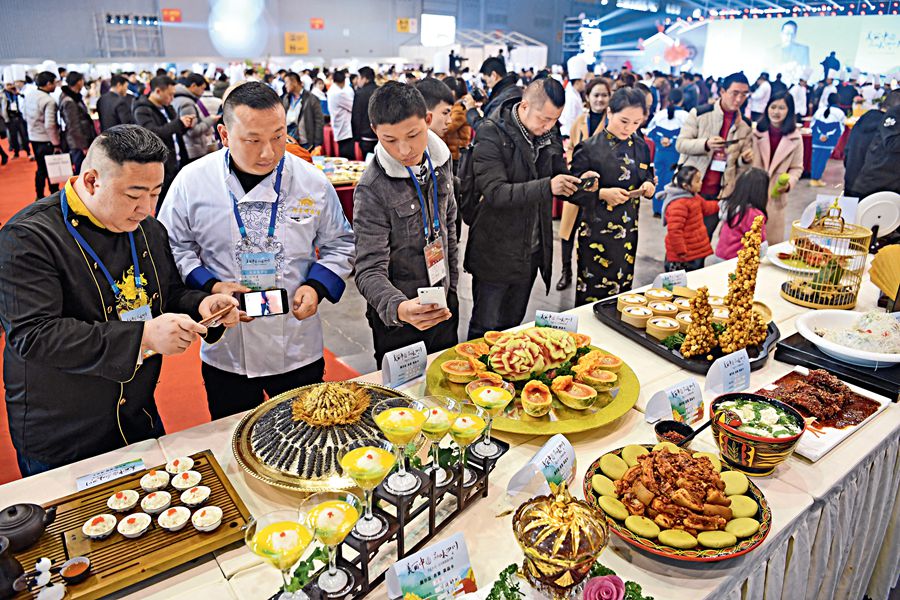THE evergreen Sichuan Province is known as “Nature’s Storehouse” due to its abundance of food and natural resources, including delicacies from the mountains, freshwater aquatic products, livestock and poultry, vegetables, and bamboo shoots, as well as a wide variety of mushrooms and other fungi. As Sichuan is endowed with a range of spices, the people of Sichuan are fond of hot and spicy taste.

Sichuan cuisine is one of the four major traditional Chinese cuisines. And there are many local variations within Sichuan Province and the neighboring Chong-qing Municipality along the Yangtze River, each having its own distinctive dishes and representative flavors. Among them, dishes of Meishan are most popular and have won the place a reputation as “the hometown of Sichuan chefs” awarded by the China Cuisine Association. Chengdu, the capital of Sichuan Province, was also awarded the title of “a city of gastronomy” as acknowledgement of the sophistication of its cooking by the UNESCO.
Chili pepper, pickles, and broad bean chili paste are essential ingredients to Sicuan cuisine. In the reign of Emperor Kangxi in the early Qing Dynasty (1644-1911), chili pepper started to be widely planted and used in the cooking of Sichuan cuisine. Later, with the creation of broad bean chili paste, modern Sichuan cuisine began taking shape. Among different types of broad bean pastes, the Pixian broad bean sauce is the most famous. Later on, the 24 varieties of frequently used flavors and 54 types of cooking styles were gradually formed, making Sichuan cuisine the most popular of the four Chinese cuisines.
The characteristics of Sichuan cuisine include tingling and numbing, spicy, fresh and aromatic, sometimes with a sweet, pot-stewed taste, represented by such renowned dishes as shredded pork with chili and soy, kung pao chicken, fish filets in hot chili oil, sliced beef and ox organs in chili sauce, spicy diced chicken, mapo tofu, and twice-cooked pork slices.
Another feature of the Sichuan cuisine is that it has learned from others over the long course of its development. The formation of Chinese cuisines usually depends on the geographic conditions and natural resources, and big rivers with abundant species are cradles for a new breed of cuisine. The Sichuan cuisine and Jiangnan cuisine all originated from the Yangtze River, thus making the integration of two branches much easier.
In the reign of Emperor Qianlong in the Qing Dynasty, Li Huanan, a Sichuanese official who once served as a local governor in Zhejiang, toured around the southern area during his tenure there, and got familiar with various delicacies of Zhejiang and Guangdong provinces. As he loved cooking and was well aquainted with Sichuan cuisine, he then set out to collect recipes from chefs, and wrote one of the earliest books about the combination of Jiangnan cuisine with Sichuan cuisine.
Shredded pork with chili and soy is a common dish in Sichuan. Although its Chinese name Yuxiangrousi indicates its connection with yu (fish), the dish has nothing to do with fish, but is cooked with various seasonings. The unique flavor and cooking technique makes it one of the most well-known traditional flavors of Sichuan cuisine. To prepare it, cut up the pork fillet as well as the carrots, bamboo shoots, and black fungi into shreds. Add a little cooking wine, starch, salt, and vegetable oil to the meat shreds and then let them marinate for half an hour. To make the sweet and sour flavored (or fish-flavored) sauce mixture, first mince the scallion, ginger, garlic; add a teaspoon of salt, a teaspoon of starch, three teaspoons of soy sauce, four teaspoons of white sugar, four teaspoons of vinegar, and five teaspoons of water. Pour the marinated meat shreds into hot pan, then stir-fry till the color turns white; lower the high temperature fire into medium, add in Pixian broad bean sauce and fry till the red chili oil comes out. Put in the shredded carrot, bamboo shoot, and black fungis, deep-fry till it is ready, then pour in the fish-flavored sauce, stir-fry for about one minute, and then place it onto the plate for serving.
Recommended
Time-Honored Brands:
Meizhou Dongpo Restaurant:
Address: 38 Kuanzhai Alley, Qingyang District of Chengdu City, Sichuan Province
Three Ears Hotpot Restaurant:
Address: 10 Nijiaqiao Road, Wuhou District of Chengdu City, Sichuan Province
Gugu Banquet Restaurant:
Address: 12 Wuhou Memorial Temple Street, Wuhou District of Chengdu City, Sichuan Province
